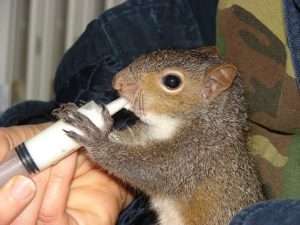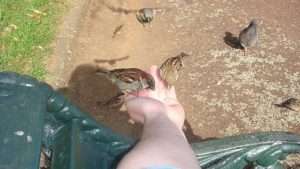 I would like to be able to say that every person engaged in wildlife rehabilitation has the proper training to know how to safely handle wildlife in ways that minimize stress and habituation. Unfortunately, this has never been the case. There are plenty of conscientious, ethical rehabs that try to handle the animals as carefully as possible and prioritize their ability to integrate back into the wild upon release. There are also individuals who, stuck without a rehab nearby, do their utmost best to help injured or ill wildlife (even if it’s illegal for unlicensed people to possess wildlife in their state); often they may contact professional rehabbers for resources and advice. And, sadly, there are those who treat wildlife they find like pets, feeding them an inappropriate diet, and making no effort to avoid habituation or stress, which can lead to problems as severe as capture myopathy.
I would like to be able to say that every person engaged in wildlife rehabilitation has the proper training to know how to safely handle wildlife in ways that minimize stress and habituation. Unfortunately, this has never been the case. There are plenty of conscientious, ethical rehabs that try to handle the animals as carefully as possible and prioritize their ability to integrate back into the wild upon release. There are also individuals who, stuck without a rehab nearby, do their utmost best to help injured or ill wildlife (even if it’s illegal for unlicensed people to possess wildlife in their state); often they may contact professional rehabbers for resources and advice. And, sadly, there are those who treat wildlife they find like pets, feeding them an inappropriate diet, and making no effort to avoid habituation or stress, which can lead to problems as severe as capture myopathy.
A big part of the problem is that many people are unable to recognize a wild animal’s stress signals. Just because an animal isn’t actively trying to escape or bite doesn’t mean it isn’t undergoing significant physical and mental stress. You may have heard of “fight or flight”, but “freeze” is another very common fear response in animals (humans included.) Think of a baby rabbit or fawn lying completely still in the grass; do you really think they aren’t terrified of the gigantic predatory animal approaching them?
Sometimes, long-term stress due to captivity can lead to capture myopathy–and once it sets in, it is frequently fatal for the animal suffering from it.
What is Capture Myopathy?
Stress can cause a lot of symptoms in an animal. Many of these are adaptations that are meant to help them survive a dangerous encounter, such as flooding the body with adrenaline to give it more oxygen and energy to fight or flee, or emptying the bladder and bowels to get rid of extra weight. Most of these symptoms subside once the danger has passed; animals aren’t meant to live in a stressed state long-term.
 But a wild animal in captivity, especially one that was not bred and raised in captivity, will often feel stressed even when it isn’t being handled. Just the act of being trapped in a cage, pen, or other container can be enough to put it in a constant state of fear and anxiety. Handling the animal just makes this experience worse, which is why you see ethical wildlife rehabbers minimizing contact with their patients rather than, say, taking them out of the cage and petting them while taking selfies and videos for social media.
But a wild animal in captivity, especially one that was not bred and raised in captivity, will often feel stressed even when it isn’t being handled. Just the act of being trapped in a cage, pen, or other container can be enough to put it in a constant state of fear and anxiety. Handling the animal just makes this experience worse, which is why you see ethical wildlife rehabbers minimizing contact with their patients rather than, say, taking them out of the cage and petting them while taking selfies and videos for social media.
The extreme of this stress is capture myopathy–the animal is literally scared to death. The animal may struggle or try to escape for so long that their muscles are severely damaged–the muscle tissue literally dies en masse. This trauma is enough to kill an animal, and there is little to be done to reverse it once myopathy has set in, as the damage has already been done. While tranquilizers and other chemical sedatives can increase the chances of capture myopathy, as can hot temperatures, it can happen under any circumstance where a wild animal is being handled. And it affects a wide range of mammals, birds, and even amphibians and fish.
Common symptoms early on can include increased temperature, and respiratory and heart rates; in fact, the elevated body temperature can cause the same effects as heat stroke. But as myopathy continues to develop, the animal may become lethargic (appearing “calm”), weak and uncoordinated, and even experience shaking and paralysis. Death can happen within hours, but it can also occur days after initial capture. If you think about it, having your muscle tissue die and begin to break down while you’re still alive and experiencing hours or days of constant panic sounds like a pretty horrific way to die.
Capture myopathy can happen even when the animal is under the best of care, with people who are handling them as little as absolutely possible. A growing recognition of this fatal condition among wildlife professionals helps them to avoid the onset of myopathy, and some veterinary and other professionals offer ways to try to treat it, especially with early symptoms like hyperthermia (overheating).
But because there is no sure way to treat capture myopathy once it shows more advanced symptoms, prevention is the best measure. That starts not just with methods of handling wildlife, but with attitudes toward wild animals.
The Importance of Respecting Wildness
 There has long been a problem of “Disneyfying” wildlife. Many people want to interact with wildlife, which is not a bad thing in and of itself. However, they want to get too close, and have the animals be as tame around them as their domestic cats or dogs. Often this is so that they can feel special because they were the chosen ones that the wild animals treated differently than everyone else. There’s also a lot of anthropomorphization of wildlife that happens, in which animal language and behaviors are misinterpreted through a human bias.
There has long been a problem of “Disneyfying” wildlife. Many people want to interact with wildlife, which is not a bad thing in and of itself. However, they want to get too close, and have the animals be as tame around them as their domestic cats or dogs. Often this is so that they can feel special because they were the chosen ones that the wild animals treated differently than everyone else. There’s also a lot of anthropomorphization of wildlife that happens, in which animal language and behaviors are misinterpreted through a human bias.
This just makes it more likely that people will miss the cues that an animal is giving that says it is stressed or scared. That “freeze” response means the animal is absolutely terrified, not that they’re think you’re their new best friend. Some people even go as far as to deliberately feed wildlife and otherwise make them lose their natural fear of humans.
And, of course, there are the would-be rehabbers who claim they’re saving wildlife, but instead of giving them space as wild beings, they treat them like pets. Even if the animals are eventually released outside, they often don’t go onto live fully natural, wild lives due to too much handling and habituation. Thus you end up with fully grown raccoons and opossums who make nuisances of themselves around the neighborhood because they learned early on that humans = an easy source of food, or crows that would rather socialize with humans than their own kind. (And occasionally you get a misrepresented “rescue” like Messi the Cougar, who is not a rescue at all but an animal purchased through the exotic pet trade, and who gives millions of people a highly inaccurate picture of how big cats should be handled in captivity.)
When we respect the wildness of wild animals–when we minimize the contact and handling only to what is absolutely necessary–we honor them more than any social media post ever could. More importantly, we reduce the chances of adding to their stress and health issues while they are in captivity for rehab. This reduces the chances of capture myopathy. It doesn’t mean such an affliction would never occur, even under ideal circumstances. But if capture myopathy can be the result of over-handling, then the antidote to over-handling is greater respect for wildness, and letting that guide our actions rather than the self-centered desire to be some special “wildlife whisperer.”
